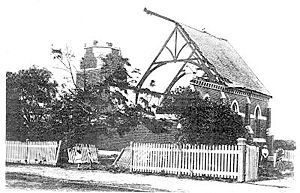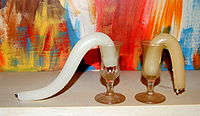
Extreme weather events in Melbourne
Encyclopedia

Melbourne
Melbourne is the capital and most populous city in the state of Victoria, and the second most populous city in Australia. The Melbourne City Centre is the hub of the greater metropolitan area and the Census statistical division—of which "Melbourne" is the common name. As of June 2009, the greater...
, Australia
Australia
Australia , officially the Commonwealth of Australia, is a country in the Southern Hemisphere comprising the mainland of the Australian continent, the island of Tasmania, and numerous smaller islands in the Indian and Pacific Oceans. It is the world's sixth-largest country by total area...
have occurred on multiple occasions. The city has experienced a number of highly unusual weather
Weather
Weather is the state of the atmosphere, to the degree that it is hot or cold, wet or dry, calm or stormy, clear or cloudy. Most weather phenomena occur in the troposphere, just below the stratosphere. Weather refers, generally, to day-to-day temperature and precipitation activity, whereas climate...
events and extremes of weather as well as the rare natural disaster
Natural disaster
A natural disaster is the effect of a natural hazard . It leads to financial, environmental or human losses...
.
List of weather events
- 1863 - A major flood puts Port Melbourne underwater leaving thousands homeless across the city and drowning one man at Princes Bridge.
- 26 July 1882 - snow fell for half an hour in Melbourne.
- 1882 - Elizabeth StreetElizabeth Street, MelbourneElizabeth Street is one of the main north-south streets in the central business district of Melbourne, Australia, part of the Hoddle Grid laid out in 1837.- Geography :...
in Melbourne was in flood. - 1891 - The great flood causes the Yarra RiverYarra RiverThe Yarra River, originally Birrarung, is a river in east-central Victoria, Australia. The lower stretches of the river is where the city of Melbourne was established in 1835 and today Greater Melbourne dominates and influences the landscape of its lower reaches...
to swell to 305 metres (1,001 ft) in width. Described as the worst flood in history it leaves thousands homeless and causes at least one death. - 1908 - A heatwave strikes Melbourne.
- 2 February 1918 - The Brighton tornadoBrighton tornadoThe Brighton tornado events were the strongest storm recorded in Melbourne to date. The tornadoes occurred on the afternoon of 2nd of February 1918, with prevailing north-westerly winds and hot sultry weather . After a severe storm formed and moved off Port Phillip, two tornadoes struck Brighton...
, an F3 class and the most intense tornadoTornadoA tornado is a violent, dangerous, rotating column of air that is in contact with both the surface of the earth and a cumulonimbus cloud or, in rare cases, the base of a cumulus cloud. They are often referred to as a twister or a cyclone, although the word cyclone is used in meteorology in a wider...
to hit a major Australian city, strikes the bay side suburb of Brighton. - 9 November to 1 December 1934 - Torrential rainfall of up to 350 mm. Yarra RiverYarra RiverThe Yarra River, originally Birrarung, is a river in east-central Victoria, Australia. The lower stretches of the river is where the city of Melbourne was established in 1835 and today Greater Melbourne dominates and influences the landscape of its lower reaches...
becomes raging torrent. Extensive damage with 35 dead, 250 injured, and 3,000 homeless. - 13 January 1939 - Melbourne experiences its second hottest temperature on record, 45.6 °C (114.1 °F), during a four-day nationwide heat waveHeat waveA heat wave is a prolonged period of excessively hot weather, which may be accompanied by high humidity. There is no universal definition of a heat wave; the term is relative to the usual weather in the area...
in which the Black Friday bushfiresBlack Friday (1939)The Black Friday fires of 13 January 1939, in Victoria, Australia, were considered one of the worst natural bushfires in the world, and certainly the single worst in Australian history as a measure of land affected...
destroy townships that are now Melbourne suburbs. - 1951 - A moderate cover of snow blankets the central business district (CBD) and suburbs.
- 3 December 1954 - Record wet day causes flooding in ElwoodElwood, VictoriaElwood is a suburb in Melbourne, Victoria, Australia, 8 km south from Melbourne's central business district. Its Local Government Area is the City of Port Phillip...
and FlemingtonFlemington, VictoriaFlemington is a suburb in Melbourne, Victoria, Australia, situated between the Maribyrnong River and Moonee Ponds Creek 4 km north-west from Melbourne's central business district. It was named by settler James Watson after Flemington estate in Scotland. Its Local Government Areas are the...
with homes also evacuated and Flinders Street and Swanston Street and major events cancelled. - 1972 - Elizabeth Street is flooded after a massive downpour of rain.
- 8 February 1983 - The city is enveloped by a massive dust storm1983 Melbourne dust stormThe 1983 Melbourne dust storm was a meteorological phenomenon that occurred during the afternoon of 8 February 1983, throughout much of Victoria, Australia and affected the capital, Melbourne. Red soil, dust and sand from Central and Southeastern Australia was swept up in high winds and carried...
that "turned day into night". - 16 February 1983 - Melbourne is encircled by an arc of fire as the Ash Wednesday firesAsh Wednesday firesThe Ash Wednesday bushfires, known in South Australia as Ash Wednesday II, were a series of bushfires that occurred in south-eastern Australia on 16 February 1983. Within twelve hours, more than 180 fires fanned by winds of up to 110 km per hour caused widespread destruction across the states...
encroach on the city. - 18 September 1984 - Storm causes flooding of 100 homes in the eastern suburbs.
- December 1990 - Heatwave causes 4 deaths.
- 26 December 1999 - Flash flooding damages 300 homes with the worst effect on BroadmeadowsBroadmeadows, VictoriaBroadmeadows is a suburb in Melbourne, Victoria, Australia, 16 km north from Melbourne's central business district. Its Local Government Area is the City of Hume...
. - December 20032003 Melbourne thunderstormThe 2003 Melbourne thunderstorm was a severe weather event that occurred over the city of Melbourne, Australia, and surrounding areas of Victoria, from 1 December to 6 December 2003...
- Freak storms - February 20052005 Melbourne ThunderstormThe 2005 Melbourne Thunderstorm was a severe weather event that occurred between 2 February and 3 February 2005 which produced 120 mm of rain in Melbourne, the highest total since records began. Every suburb in Melbourne, parts of eastern Victoria and the Geelong/Bellarine Peninsula were...
- Freak storms - January 2009 - A heatwave2009 southeastern Australia heat waveThe early 2009 southeastern Australia heat wave was a heat wave that commenced in late January and led to record-breaking prolonged high temperatures in the region. The heat wave is considered one of the, if not the, most extreme in the region's history. During the heat wave, fifty separate...
results in a record three successive days over 43 °C (109.4 °F). This is closely followed by Melbourne's hottest day on record on 7 February, when the temperature reached 46.4 °C (115.5 °F) in the CBD. This same heatwave triggered the Black Saturday bushfires, the worst in Australian history. - 6 March 2010 - Storms2010 Victorian stormsThe 2010 Victorian storms were a series of storms that passed through much of the Australian state of Victoria on 6 March and 7 March 2010. One of the most severe storms passed directly over Greater Melbourne, bringing lightning, flash flooding, very large hail and strong winds to the state's capital...
pass directly over Melbourne bringing large hail, flash flooding and high winds, causing widespread damage across western and central Victoria, stopping all modes of transportation in Melbourne. CBD streets of Flinders, Spencer and Elizabeth were spectacularly flash flooded. - 10 November 2011 - Severe storm caused flash flooding in Croydon and Frankston.
Highest temperatures

Black Thursday (1851)
The Black Thursday bushfires were a devastating series of fires that swept the state of Victoria, Australia on 6 February 1851. They are considered the largest Australian bushfires in a populous region in recorded history, with approximately 5 million hectares, or a quarter of Victoria, being burnt...
) – 7 February 2009 (Black Saturday) – 13 January 1939 (Black Friday
Black Friday (1939)
The Black Friday fires of 13 January 1939, in Victoria, Australia, were considered one of the worst natural bushfires in the world, and certainly the single worst in Australian history as a measure of land affected...
)

